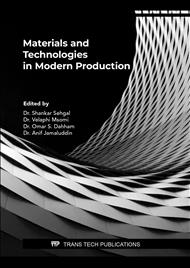p.3
p.17
p.27
p.37
p.49
p.61
p.73
p.93
p.105
Impact of CNC Milling Parameters on Temperature, Surface Roughness, and Chip Formation of General Purpose PMMA
Abstract:
This study evaluates the impacts of machining parameters on the milling of general-purpose poly (methyl methacrylate) (PMMA) with respect to cutting point temperature, maximum machining temperature, and surface roughness. The machining parameters used in the analysis are spindle speed (rpm), depth of cut (mm), and feed rate (mm/min). The extreme ranges of the machining parameters for the material are obtained from trial experiments. From these experiments, four values of each parameter are adopted. This yields 12 experiments, which are divided into three sets. In the first set of experiments, the depth of cut and feed rate are held constant at 0.2 mm and 25 mm/min, while the spindle speed is varied from 1000 rpm to 4000 rpm. In the second set of experiments, the spindle speed and feed rate are held constant at 1000 rpm and 25 mm/min, respectively, while the depth of cut is varied from 0.2 mm to 1.1 mm. In the last set of experiments, the spindle speed and depth of cut are held constant at 1000 rpm and 0.2 mm, respectively, as the feed rate is varied from 25 mm/min to 100 mm/min. Thermal images are obtained during milling, where the cutting point and maximum machining temperatures are obtained. The milled surfaces are then investigated for surface roughness. The chips are also collected from each experiment and used in conducting chip morphology. From the results, it is observed that to obtain the least temperatures and best surface quality, the least machining parameters should be chosen. These parameters are identified as 1000 rpm, 0.2 mm, and 25 mm/min for the spindle speed, depth of cut, and feed rate, respectively. An increase in spindle speed seems to increase the milling temperatures and surface roughness, which is attributed to the reducing chip thickness. An increase in the depth of cut does not affect the generation of chips, and the thickness is relatively constant. However, an increase in milling feed increases the chip thickness, which increases the surface roughness.
Info:
Periodical:
Pages:
49-59
Citation:
Online since:
June 2022
Price:
Сopyright:
© 2022 Trans Tech Publications Ltd. All Rights Reserved
Share:
Citation:



